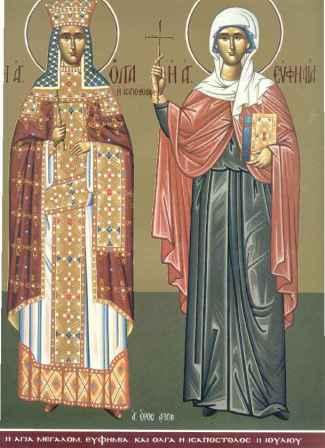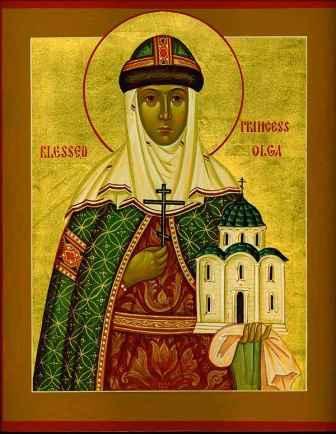|
|
The Holy and Great Martyr Euphemia This saint is commemorated on September 16th, the day on which she suffered. On this day is commemorated the miracle wrought by her precious relics, revealed at the time of the Fourth Ecumenical Council in Chalcedon. This Council was called together in the reign of the Emperor Marcian and the Empress Pulcheria, in 451, after the death of the Emperor Theodosius the Younger, and was summoned because of the heresy of Dioscorus, Patriarch of Alexandria, and Eutyches, an archimandrite in Constantinople, who had disseminated the false teaching that there were in Christ not two natures, divine and human, but only one, a divine nature. At this Council, the chief role was played by Anatolius, Patriarch of Constantinople and Juvenal, Patriarch of Jerusalem. Because, through the quarrels and evidence on both sides, no decision could be reached, Patriarch Anatolius suggested that the Orthodox and the heretics each write down their confession of faith, and that they be put into the coffin that contained the relics of St Euphemia. All agreed to this. Two confessions of faith, then, were written and placed in the hands of the great martyr. The coffin was closed and sealed with the imperial seal, a watch then being set over it. They then all spent three days in fasting and prayer. On the fourth day, when the tomb was opened, they saw the Orthodox confession of faith in the saint"s right hand and the heretical one beneath her feet. Thus was the conflict resolved by God"s power, on the side of Orthodoxy. In the time of the Emperor Heraclius, the relics of St Euphemia were translated from Chalcedon to Constantinople, to the church dedicated to her near the Hippodrome. The iconoclast Emperor Leo the Isaurian ordered that her relics be thrown into the sea; but, by a wonderful act, the coffin was brought to the is an o Lemnos and placed in the church of the holy martyr Glykeria. Then, in the time of the Empress Irene, the coffin with its relics was again taken to Constantinople, to its former place. Blood has flowed from these relics from time to time, to the succour of the sick and the feeble . This saint is commemorated on September 16th, the day on which she suffered. On this day is commemorated the miracle wrought by her precious relics, revealed at the time of the Fourth Ecumenical Council in Chalcedon. This Council was called together in the reign of the Emperor Marcian and the Empress Pulcheria, in 451, after the death of the Emperor Theodosius the Younger, and was summoned because of the heresy of Dioscorus, Patriarch of Alexandria, and Eutyches, an archimandrite in Constantinople, who had disseminated the false teaching that there were in Christ not two natures, divine and human, but only one, a divine nature. At this Council, the chief role was played by Anatolius, Patriarch of Constantinople and Juvenal, Patriarch of Jerusalem. Because, through the quarrels and evidence on both sides, no decision could be reached, Patriarch Anatolius suggested that the Orthodox and the heretics each write down their confession of faith, and that they be put into the coffin that contained the relics of St Euphemia. All agreed to this. Two confessions of faith, then, were written and placed in the hands of the great martyr. The coffin was closed and sealed with the imperial seal, a watch then being set over it. They then all spent three days in fasting and prayer. On the fourth day, when the tomb was opened, they saw the Orthodox confession of faith in the saint"s right hand and the heretical one beneath her feet. Thus was the conflict resolved by God"s power, on the side of Orthodoxy. In the time of the Emperor Heraclius, the relics of St Euphemia were translated from Chalcedon to Constantinople, to the church dedicated to her near the Hippodrome. The iconoclast Emperor Leo the Isaurian ordered that her relics be thrown into the sea; but, by a wonderful act, the coffin was brought to the is an o Lemnos and placed in the church of the holy martyr Glykeria. Then, in the time of the Empress Irene, the coffin with its relics was again taken to Constantinople, to its former place. Blood has flowed from these relics from time to time, to the succour of the sick and the feeble .St Elena (Olga) A great Russian princess, the wife of Prince Igor, she was called Olga before her baptism. She was baptised in Constantinople by Patriarch Polyeuctus, and was greatly zealous for the Orthodox faith in Russia. She entered into rest in 969. A great Russian princess, the wife of Prince Igor, she was called Olga before her baptism. She was baptised in Constantinople by Patriarch Polyeuctus, and was greatly zealous for the Orthodox faith in Russia. She entered into rest in 969.Our Holy Father, the Martyr NicodemusBorn in Elbasan, he was married and had children. Duped by the Turks, he embraced Islam and forced his children to do likewise, with the exception of one son who fled to the Holy Mountain and became a monk. Nicodemus went to Athos to take his son back, but the place made such an impression on him that he repented, returned to the Christian faith and became a monk himself. He bewailed his apostasy for three years, then decided to return to Albania, to expiate his sin there where he had committed it. He therefore returned, informed the Turks that he was a Christian and was beheaded on July 11th, 1722. His wonderworking relics are preserved today whole and uncorrupt.
Our Holy Father, the Martyr NectariusBorn in Vryoulla in Asia Minor, he was forced to accept Islam at the age of seventeen. His fate was similar to that of St Nicodemus. When he showed himself to his mother as a Turk, she cried at him: "Get away from me! I don"t know you. I bore you as a Christian, not as a Turk!" He repented bitterly, went to the Holy Mountain and there, in the skete of St Anne, became a monk. Having resolved to die for Christ and thus take away his sin, he went again to Vryoulla, where he suffered. He was beheaded for Christ by the Turks in his birthplace on July 11th, 1820, at the age of twenty-one.
Hieromartyr Cindeus of Pamphylia (3rd-4th c.) The Holy Martyr Kindeios was a presbyter in the village of Sida, in Pamphylia, Asia Minor. During the time of the persecution against Christians by the emperor Diocletian (284-305), Saint Kindeios was arrested and as a Christian sentenced to burning. The soldiers leading him to execution along the way encountered a wood-cutter with a large bundle of firewood, and by force they confiscated the firewood as kindling for the bon-fire. But Saint Kindeios demanded 30 copper coins of them to pay the wood-cutter, and then he took up the burden upon his own shoulders and carried it to the place of execution. With the help of God, Saint Kindeios even in the bon-fire remained a steadfast warrior of Christ, and amidst the flames he found within himself the strength to call the people standing about to accept the true faith and the grace of the Lord. At this point a strong thunderstorm broke out with a downpour of rain, and the bon-fire went out. When the storm abated, the holy martyr peacefully gave up his soul to Christ. Present at the martyrdom was a pagan priest who listened to the preaching of the holy Martyr Kindeios, and he together with his wife came to believe in Christ, and it was they who consigned to burial the body of the holy Martyr Kindeios. The Holy Martyr Kindeios was a presbyter in the village of Sida, in Pamphylia, Asia Minor. During the time of the persecution against Christians by the emperor Diocletian (284-305), Saint Kindeios was arrested and as a Christian sentenced to burning. The soldiers leading him to execution along the way encountered a wood-cutter with a large bundle of firewood, and by force they confiscated the firewood as kindling for the bon-fire. But Saint Kindeios demanded 30 copper coins of them to pay the wood-cutter, and then he took up the burden upon his own shoulders and carried it to the place of execution. With the help of God, Saint Kindeios even in the bon-fire remained a steadfast warrior of Christ, and amidst the flames he found within himself the strength to call the people standing about to accept the true faith and the grace of the Lord. At this point a strong thunderstorm broke out with a downpour of rain, and the bon-fire went out. When the storm abated, the holy martyr peacefully gave up his soul to Christ. Present at the martyrdom was a pagan priest who listened to the preaching of the holy Martyr Kindeios, and he together with his wife came to believe in Christ, and it was they who consigned to burial the body of the holy Martyr Kindeios.Venerable Nicodemus of Hilandar and Vatopedi, Mt. Athos (14th c.)Venerable Leo, monk, of Mandra
|